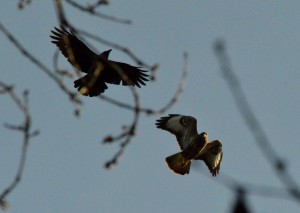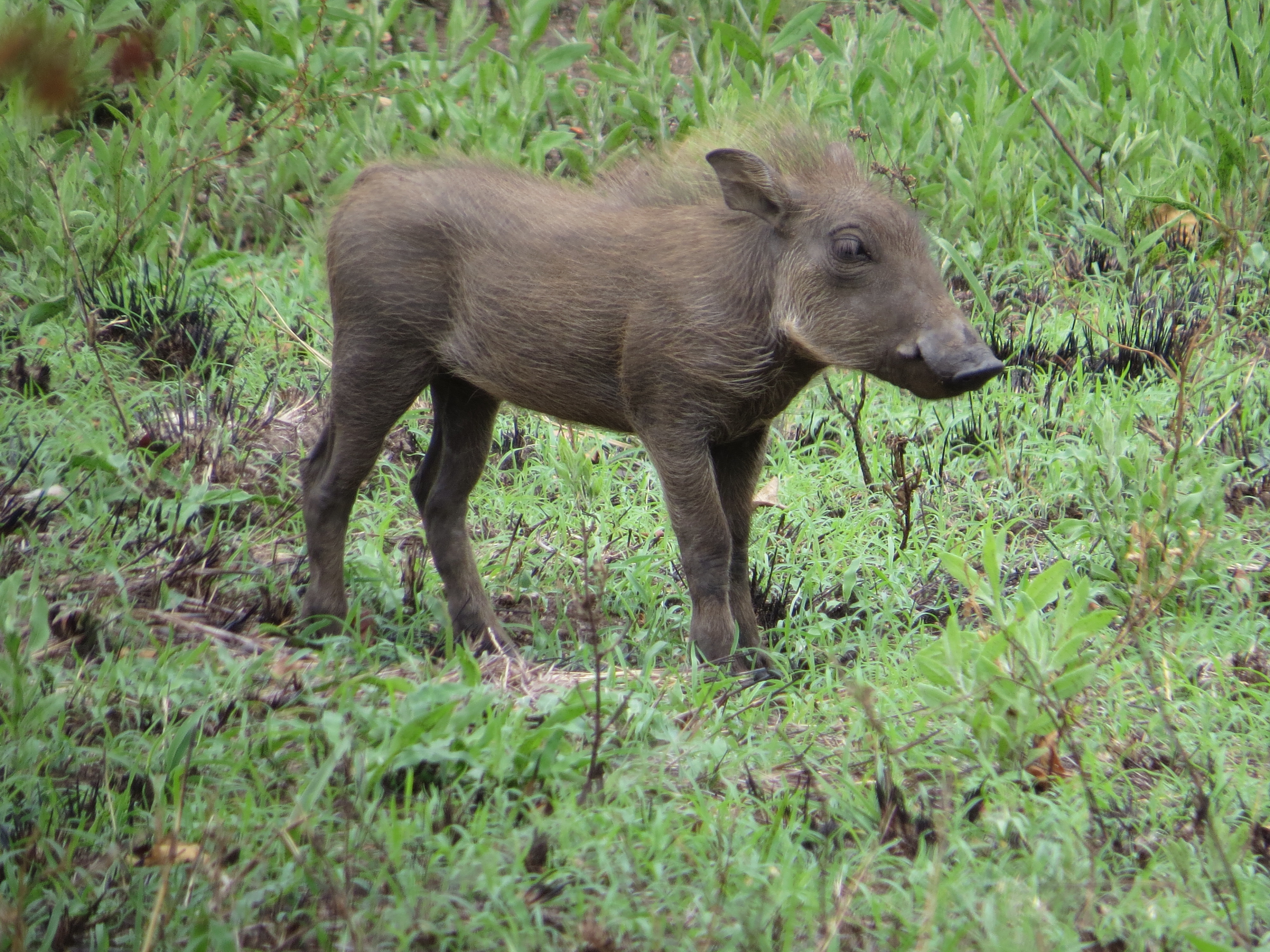On Wednesday January 14th the Pat Kenny show on Newstalk radio station hosted Professor Luke O’Neill (a prominent Trinity College Dublin Immunologist), in a segment exploring the causes of the huge declines seen in European bird populations newstalk.ie/player/podcast. Comments from both Professor O’Neill and Mr. Kenny implicating raptors and corvids in these bird declines provoked a storm on social media. Every Irish environmental NGO has strongly condemned these implications. Professor O’Neill was not in possession of the full facts and has apologised*. Predatory birds are not responsible for severe declines in many bird populations [1] and here at TCD EcoEvo we lay out the real reasons for these declines and show why natural predators like Red Kites, White-tailed Sea-eagles and Golden Eagles are in fact of huge benefit to ecosystems. Continue reading “Predators: feathered friend or foe?”
Ecology of religious beliefs
It is well known that your country of birth has a big influence on your religious outlook. That’s why Ireland is dominated by Christians whereas Iran has a mostly Muslim population. Your scientific outlook doesn’t escape from this either. For instance, it’s arguable that the idea of group selection is viewed much more favourably in the US than the UK. Turning back to religion, a group of authors have recently carried out a study on the ecology of religious belief. In their work they were able to predict the societies that believe in moralising high Gods by drawing on historical, social and ecological data.
As we’re in the beginning, we need a definition, so what exactly is a moralizing high God? These are “supernatural beings believed to have created or govern all reality, intervene in human affairs, and enforce or support human morality”. Supernatural belief has had a number of ecological correlates associated with it and this study points to environmental instability as one major driver. An environment with an unpredictable spatial or temporal distribution of resources lends itself to cultivating cooperation among the animals found within it. Among humans this results in a “reduction in cheating, increased fairness, and a tendency to cooperate”. And this is a fertile ground for the development of religious belief. One conclusion is that cultures in close proximity or those that share a common language exhibit similar religious beliefs.
However, the authors nuance this statement that this form of religion is being driven as a response to environmental harshness. In fact, they note that for societies living in a really harsh environment like the Inuits, variations tend to lead to more positive periods rather than negative ones and this seems to inversely correlate with the probability of believing in these type of gods.
One ironic point however (largely discussed in Jerry Coyne’s blog post), is that this paper is also influenced by the authors’ societal framework: a society traditionally believing in a god that they consider as moral and improving human lives. Taking that into account, some parts of the methodology heavily influence the results. The definition of morality by the authors and its benefits on humans as a species are highly depend on the societal framework where one is born. The “reduction in cheating, increased fairness, and a tendency to cooperate” is traditionally seen as a “good” thing for humanity in Abrahamic religions. Making it a universal or biological “right” behaviour is only the authors’ point of view (and probably one of their funding agencies).
Author: Adam Kane & Thomas Guillerme, @P1zPalu and @TGuillerme
Photo credit: http://mattleese.blogspot.ie/2009/12/we-dont-know-if-jesus-ever-rode-them.html
Career planning for PhD students
 The Royal Society has published a new set of guidelines for managing the career expectations of PhD students in STEMM subjects (science, engineering, technology, maths and medicine). The publication was the result of a series of roundtable discussions held at the Royal Society with PhD students, supervisory teams and University careers professionals.
The Royal Society has published a new set of guidelines for managing the career expectations of PhD students in STEMM subjects (science, engineering, technology, maths and medicine). The publication was the result of a series of roundtable discussions held at the Royal Society with PhD students, supervisory teams and University careers professionals.
This blog post from the British Ecological Society provides a good overview of the document and discussion of how it fits into existing career development opportunities for PhD students.
With ever increasing numbers of PhD graduates and restricted academic jobs, academic careers are becoming the exception rather than the rule in many STEMM disciplines. The report highlights the need for PhD students to be realistic about their career expectations and goals and the importance of continuous professional development during their studies.
The document contains guidelines and recommendations for students, supervisors, career professionals and higher education institutions. It’s very encouraging to see that the training and mentoring of ecology and evolutionary graduate students at TCD already follows many of the principles.
This is mainly due to the success of NERD club, our weekly meeting of ecology and evolution researchers. The primary purpose of this group is to develop research projects and encourage new collaborations but many sessions are also devoted to career development. We have discussed academic careers advice and application tips but also non-academic careers and the transferrable skills such as public communication and teaching that can be applied to any career choice. As students, we’re very lucky to benefit from the mentoring and advice of enthusiastic and dedicated staff members.
One aspect of the Royal Society guidelines which I hadn’t considered previously is the recommendation that PhD students should seek a mentor who is not their supervisor for career advice. It’s an interesting suggestion, especially since many supervisors have limited personal experience of non-academic careers, and a good thing to consider for any PhD student.
Hopefully these new guidelines will encourage more students, supervisors and institutions to make broad career planning an integral part of every PhD student’s experience.
Author: Sive Finlay, @SiveFinlay
Photo credit: http://sironaconsulting.com/2009/10/29/my-top-10-funny-job-interview-cartoons/
South Africa’s topsy-turvy seasons
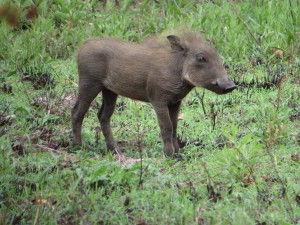
It’s easy to forget that seasons work in different ways in different places. On a recent trip to Kruger National Park in South Africa, I was expecting to see European breeding birds. I was also expecting that South Africa would be enjoying a season similar to a European spring; a simple six-month discrepancy with the northern hemisphere. While I found the European birds, including Swifts, Swallows, Cuckoos and Willow Warblers, I found a rather different type of spring. South Africa has very short transition seasons (spring/autumn) and more extended hot/cold (winter/summer) seasons. Over much of South Africa, summer (mid-October to mid-February) is a hot and sunny season, frequently accompanied by afternoon thunderstorms. In Kruger, summer is marked by the beginning of the “wet” season and the birth of new Impala, Wart Hogs and Wildebeest. However, the majority of the resident mammals don’t have a breeding “season”; all of the “Big 5” (buffalo, elephant, rhino, leopard and lion), can give birth to young in any month.
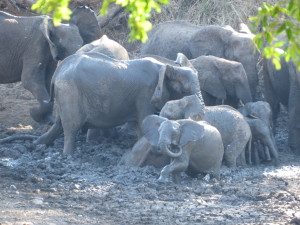
The native people of the Limpopo and Mpumalanga provinces have incorporated the link between the birth of impala and the arrival of rain into folklore. Their stories say that impala are the animals that decide when it should rain. If the rain is early, the impala need it early, if the rain is late, the impala are not ready for it at the usual time. While I thought that might make the impala unpopular, it seems they are held in high esteem.
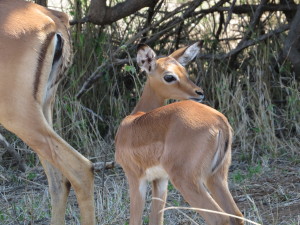
As well as the transcontinental migrant birds (like the Swallows and Cuckoos I mentioned earlier), Africa has numerous bird species which migrate within the continent. In November (the date of my visit), the Woodland Kingfishers arrive in Kruger.
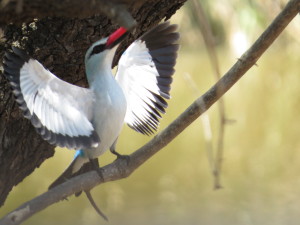
Their arrival is probably timed to coincide with the rise in insect numbers, following the new growth triggered by the rains, because Woodland Kingfishers feed on grasshoppers, locusts and beetles, rather than fish.
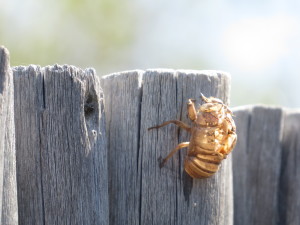
For an ecologist, migration is a fascinating area of study, especially when closely-related species compete for food at different times of year. Indeed, the migrant Woodland Kingfishers compete with resident Brown-hooded Kingfishers for food. By coincidence, a study considering such questions has just started in Kruger.
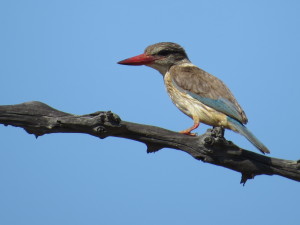
Author: David Kelly, djkelly[at]tcd.ie
Photo credit: David Kelly
Christmas wish list
 For our last post before the Christmas break we decided to collect people’s scientific Christmas wish lists from the department. We got a diversity of answers ranging from the realistic to the fantastical.
For our last post before the Christmas break we decided to collect people’s scientific Christmas wish lists from the department. We got a diversity of answers ranging from the realistic to the fantastical.
Thomas Guillerme wants a super computer “that runs everything instantly, like if you have to run a loooooooong MCMC, it spits out the results instantly.”
Natalie Cooper says “I’d like an automatic marking machine that could grade coursework and exams for me while I eat mince pies and drink tea. Failing that I’d like some friendly elves who would grade them for me while I sleep. And yes, as you may have guessed, I do have a stack on marking on my desk!”
Darren O’Connor asks for “Swarovski EL 8.5 x 42 binoculars. Their optic wizardry and quick fire focus make them unbeatable in the field.”
Aoibheann Gaughran says “what I would like is the gift of great mathematical/statistical comprehension (a little chip implant in my brain would be great!). Can I have two? Id also like the gift of speed-reading. Combined, they would mean I could quickly read all of the relevant literature, formulate a decent hypothesis to test and analyse the results with confidence.”
David Kelly is looking for “A twenty-first century view of new vertebrate species from the ICZN, to avoid the collection of voucher specimens. Even with full genome phylogenies, high-definition photography and 3D printers, the collection (i.e. deliberate killing) of type specimens remains an inescapable part of the description of new species.”
Sean Kelly is expecting big things, “An unlimited funding stream would be handy… I’d love some tiny electronic devices that can provide super accurate geographical positioning data and take high resolution video footage, as well as being able to remotely transmit all this data via satellite. I could then attach these wee devices to the beaks of birds and just wait for the mountains of data on the birds movement ecology and migration patterns, diet and feeding ecology, competitive interactions, etc, etc, to just roll in. Simples. If they’re out of stock, I’ll take a machine that sequences a bird’s full genome from a single feather.”
Kevin Healy is pragmatic, he wants “a permanent job in science that pays at least the average industrial wage”.
Adam Kane wants some new tech “I’d love an air wing of drones to spy on wildlife all from the comfort of my office.”
Deirdre McClean is looking for “an automated counter microscope that could continuously count protist and bacterial cells to make my lab life easier so I could focus on the fun parts of experiments.”
Pitch in with what you’d like to get to make your research that bit easier or more enjoyable.
Author: ecoevoblog
Photo credit: wikimedia commons
Literacy Levels
 Scientists and science communicators often make the point that the public are scientifically illiterate and that this needs to change. But why? The line goes that as we live in an age of science so everyone should be comfortable reading, writing and talking about science such is its pervasiveness in 21st century society. Robert Hazen argues for the importance of literacy saying, “A scientifically illiterate person is effectively cut off from an immensely enriching part of life, just as surely as a person who cannot read” (1). However scientific literacy is not something that is easily defined. So it is important to look at the various conceptions of it before asking if we can improve it.
Scientists and science communicators often make the point that the public are scientifically illiterate and that this needs to change. But why? The line goes that as we live in an age of science so everyone should be comfortable reading, writing and talking about science such is its pervasiveness in 21st century society. Robert Hazen argues for the importance of literacy saying, “A scientifically illiterate person is effectively cut off from an immensely enriching part of life, just as surely as a person who cannot read” (1). However scientific literacy is not something that is easily defined. So it is important to look at the various conceptions of it before asking if we can improve it.
Many authors consider science as more than a body of facts or something to be learned by rote and bemoan the dry science curricula, “It has for long been my contention that we are crushing our students into the flatness of equation-grinding automatons and forcing them into blind memorization of problem-solving procedures.” For example, there is the argument that scientifically literate individuals should possess a skill set of attributes and, for instance, be able to answer “How do we know …?” and “Why do we believe …?” questions (2). Richard Feynman said as much when he emphasised the important distinction between knowing the name of something and knowing something. There’s a world of difference between a person who can list off every bird species name and someone with an education in ornithology.
In contrast, it’s been argued that a pursuit of scientific literacy for all is futile. There are two purported stumbling blocks to widespread scientific literacy: the cumulative nature of science, resulting in an ever increasing amount of information and science’s use of counter intuitive descriptions (3). These barriers are so great as to prevent the majority of people attaining literacy. Instead we should engender an appreciation of science. The point is that a person’s early encounters with science involve fascination and curiosity, only for this to give way to courses that stress memorisation and dry subject matter.
But I think this is overly pessimistic. The important concepts in science are readily explicable to a lay person and the same goes for the process of making hypotheses. Even quantum physics, that byword for the impossible, has a legion of eager physicists who draw on a series of ingenious analogies to convey the main points behind it. I would suggest that there is a scale of scientific literacy from an appreciation of science, on to an understanding of how science works and then on to knowing the particulars of a given area i.e. a scientific vocabulary.
References
- Hazen RM. Why should you be scientifically literate. ActionBioscience org. 2002.
- Arons, A.B. (1983). Achieving Wider Scientific Literacy. Daedalus. 112 (2), p. 91-122.
- Shamos, M. 1988. The lesson every child need not learn. The Sciences 28(4):14–20.
Author: Adam Kane, kanead[at]tcd.ie
Photo credit: www.hetemeel.com
Vox populi – when science and the public engage
 Scientists are now being held to greater accountability by a variety of communities (both public and private), and the idea that scientists should be trusted to work in the interest of the public good, by virtue of their profession, is no longer accepted. So we now have a situation where government leaders and policy makers worldwide are finding ways to effectively communicating science and technology issues to the public and to include citizens in science and technology decision-making processes. This is a process termed upstream public engagement. Successful dialogue should prevent the given scientific issue from becoming ‘evidence-resistant’ which seems to have happened with genetically modified organisms where public fear of GMOs is a serious constraint.
Scientists are now being held to greater accountability by a variety of communities (both public and private), and the idea that scientists should be trusted to work in the interest of the public good, by virtue of their profession, is no longer accepted. So we now have a situation where government leaders and policy makers worldwide are finding ways to effectively communicating science and technology issues to the public and to include citizens in science and technology decision-making processes. This is a process termed upstream public engagement. Successful dialogue should prevent the given scientific issue from becoming ‘evidence-resistant’ which seems to have happened with genetically modified organisms where public fear of GMOs is a serious constraint.
It has been pointed out that when the public are left out of any such dialogue it should come as no surprise that they are distrustful of the outcomes of the resulting applications. Yet a number of arguments have been levelled against public participation in science. Bill Durodié cites four reasons that count against public participation: demoralising scientists, patronising the public, elevating new ‘experts’ and deflecting blame. However, I think his arguments are alarmist and have a number of faults which undermine his contention with public participation.
He argues that including lay opinions will result in science and scientists becoming marginalised. He says “But science is not ‘just another point of view’. It may be culturally situated, but this does not mean that it is only contextually valid.” Such a conflation of lay opinions with expert evidence would of course be disastrous but this is not what public participation is about. Upstream engagement would allow people to understand the potential risks of a science in its infancy.
According to Durodié “By having to make science more ‘accessible’ in order to be ‘inclusive’, this ends up by diluting the detail, eroding the evidence and trivialising the theory.” But simplifying science happens among scientists and science communicators all the time. Experts always have to frame their ideas to allow for ideas to be communicated to a specific target audience.
The nanotechnology seems to be taking stock of the consequences that a bad PR campaign can have. The GM debate has resulted in a ‘nanophobia-phobia’, i.e. “the phobia that there is a public phobia [,]” with respect to nanotechnology (Joly and Kaufmann 2008). The so-called emerging technologies of nanotechnology, biotechnology, information technology and cognitive science will certainly require upstream engagement with the public.
Computer scientist Bill Joy (2000) advocated a policy of relinquishment for such technologies which he deemed too dangerous. Science does not have any inbuilt mechanism to determine if research should continue; there is no moral component to the scientific method. And although I do not agree with Joy’s viewpoint, such anxiety demonstrates that certain areas of science require public upstream engagement. Indeed some commentators rightly point out that uncertain science can have an ethical and moral component and lay people are just as entitled to have their say in this respect. It is encouraging that some scientists have the prescience to recognize potential dangers of upcoming technology.
Author: Adam Kane
Photo credit: Wikimedia commons
References
Jackson, R Barbagallo, F Haste, H . (2005). Strengths of Public Dialogue on Science-related Issues. Critical Review of International Social and Political Philosophy. 8 (3), p. 349–358.
Joy, B. (2000). Why the future doesn’t need us. Available: http://www.wired.com/wired/archive/8.04/joy.html.
When Worlds Collide – Science Vs Hollywood
Film directors often call on scientific experts to lend some legitimacy to their production. A recent, notable example was that of the theoretical physicist Kip Thorne advising Christopher Nolan on the realism of the physics in Interstellar. I think directors ask for the counsel of scientists in cases where they seek to make a film with at least one foot in reality rather than an outright fantasy. In Jurassic Park, a more biologically relevant movie, director Stephen Spielberg had noted-palaeontologist Jack Horner instruct the production team of the latest findings in dinosaur biology. The book and film of Jurassic Park had a significant effect on the public perception of dinosaurs coming as they did in the wake of the dinosaur renaissance of the 80s where the animals were reappraised as fleet footed, intelligent creatures. This was a radical departure from the image of tail dragging sluggards common in the early part of the 20th century (see King Kong). For instance, Horner was quick to quash the idea of a snake-like forked tongue for the Velociraptors. This was a great example of science and art working together in symbiosis. The film was a box office success and the public consciousness was updated to have in mind a more accurate image of what dinosaurs were really like. Of course the film wasn’t perfect in its representations and nitpickers had plenty of grist for their pedantic mills, but overall both ‘sides’ were happy.
But now the release of the trailer for the 4th film in the series, Jurassic World, has caused consternation among palaeontologists. It’s clear from the footage that the dinosaurs haven’t evolved along with the science as they did with the first film. Mainly, that means no feathered animals; perhaps the studio executives weren’t convinced that a fluffy Tyrannosaurus could induce as much panic in an audience. Capturing the disappointment in the scientific community, John Conway writes, “Of course we realise it’s a film – but we also recognise the power it will have to shape people’s ideas about prehistoric animals. And in Jurassic World’s case, it looks like we’re getting a very dull monsters trope. ” This leads to the question as to what does Hollywood owe science? It’s a hard one to answer because there’s no moral imperative for a director to follow the strictures of scientific fact exactly. James Erwin says “The truth is that science fiction is, first and foremost, fiction—and that’s how it should be judged.” I agree with this to an extent, in that if a director is striving to give a message and has to break away from scientific reality to achieve this than so be it. Think of something like the ability of characters to invade dreams in Nolan’s Inception. Nevertheless in the case of Jurassic World I’d bet we’re going to get yet another discussion of man’s hubris , a trope that has been reiterated throughout the Jurassic Park series. If they were able to do this while creating the most realistic dinosaurs at the time in 1993 I don’t see why they couldn’t continue to do so in 2015. Maybe it just rankles with me that we’re seeing another edition in a series of diminishing returns and I should check my hopes. I wonder what other people think of this? But it’s still frustrating for me. Lost World? More like Lost Opportunity.
Author: Adam Kane, kanead[at]tcd.ie
Photo credit: wikimedia commons
Public service announcement: How not to email a professor
Quite regularly you get emails that annoy you… often they are flippant emails, and sometimes from students. Harmless or probably naïve that they are, they do get up some peoples’ noses.
But every once in a while you get one that really gets your goat. Several months after some media coverage of a research paper from my group (as it happens one of my favourite papers I’ve been involved with of all time) I got a real gem of an email.
“Woah!!! Who the F*%K is this guy and why is a CEO of an internet security company sticking his nose into what at this stage is an old press release for a research paper?” was my first impression. This guy just doesn’t get it was what I settled on in the end… but here is what played out.
Turns out Luke Latham has published 4 research papers with a modelling angle. He seems to have a bee in his bonnet though. He also has a knack for writing a totally rude and irritating email that only incited me to reply mirroring his rudeness – a subtlety of irony apparently lost on him. I have posted all the emails, along with some pointers as to how he managed to stuff up a perfectly reasonable email in the first instance. In the end I ignored this for my own sanity, and only now got around to writing up this blog post without getting too annoyed. My advice on how not to write like a [insert derogatory word of your choice] is in italics.
The icing on the cake was that he wrote to one of my colleagues (not my line manager) and told them they shouldn’t give me tenure because I was rude! I just don’t think this guy does social interactions very well. Needless to say he was told that it was totally inappropriate for him to try to influence decisions like that, and in any case, the Irish system is not like the USA one, and as it happens, I am tenured!
——————————————————
On 8 September 2014 15:51, Luke Latham <luke@guardrex.com> wrote:
Subject: Major FAIL on one of your press releases [oh man.. before he has even begun this has annoyed me. “Major FAIL” is confrontational to say the least… I’m really hacked off already.]
Hello, [uh oh… the bad start continues… Dear Sirs/Madams/Prof/Andrew would have been better. This doesn’t bode well… ‘who is this dude’ I’m thinking]
Referring to: http://www.tcd.ie/Communications/news/pressreleases/pressRelease.php?headerID=2424&pressReleaseArchive=2012
The passage:
“Scientists have discovered proof that the evolution of intelligence and larger brain sizes can be driven by cooperation and teamwork, shedding new light on the origins of what it means to be human. ”
There is no such thing as “proof” in empirical science based on statistical models. Whomever wrote that summary of the research in your office is a scientific ignoramus. Scientists are not in the business of “proving” things. It is true that with an overwhelming amount of statistical and observational data, we lift a hypothesis to the level of calling it a “theory” and give it a special place as a scientific principle, but no single study can ever provide enough information to make a theory … and even theories are falsifiable in principle.
[Entirely correct about falsifiability of hypotheses.. but I stand by this statement…. “intelligence… can be driven by cooperation…” is the key finding… with emphasis on “can”. People have speculated for ages that it should drive it, and we showed, I think for the first time, that it can. Whether other selection pressures exist in place or tandem with this is beyond the scope of our paper. We did not say we proved that intelligence in humans was driven by cooperation, but that it could be. I see nothing at all wrong with this statement, no matter how pedantic one wants to get]
Next, you’re way, way off base claiming that this sheds new light on “what it means to be human.” The researchers’ 50 brain computer models that were run through a series of computer games (also vastly simplified over real-life interactions) were so simplistic and unlike real brains that its virtually impossible to draw any conclusions about such a correlation in real organisms. There is nothing wrong with computer simulation per se, as they can be quite helpful in research, but let’s put simulations in context: Simulations can point you in the direction of possible real-life biological relationships but never be used to draw firm conclusions about biological organisms. Simulations are just too vastly oversimplified to guarantee that the phenomenon under study will yield the same results when experiments are carried out on real organisms. Only empirical research on organisms themselves can be used to draw conclusions about organisms.
[I disagree, but I’m not getting into this here. This is a perfectly reasonable question, and one I would have been more than happy to engage with had Luke Latham, CEO not been such a jerk]
Educators (at least here in the US) have utterly failed to teach people what science is and how science works, and you jumped right on the bandwagon spreading misinformation. I think you should release a retraction on those statements in a new press release. In the future, I hope you will run your press releases that deal with scientific subjects past a REAL scientist before publication.
[I’m rather proud about how I, and my group communicate science to the discipline and to the wider public. We have a good track record of public engagement. This is just insulting, but again, I don’t think he gets it. He has also implied that we have “utterly failed” which is just inflammatory. And worst of all…. I was the “REAL scientist” that helped to write and ultimately signed off on that press release… so “[insert expletive of your choice here] you Luke Latham, CEO”]
Luke Latham, CEO
GuardRex Corporation
Cheyenne, Wyoming, USA
———————————————————————————-
So… in spite of my better judgement, I replied… and hastily… (though I don’t regret anything)
———————————————————————————-
Date: Mon, 8 Sep 2014 16:09:24 +0100
Subject: Re: Major FAIL on one of your press releases
From: a.jackson@tcd.ie
hello to you too [this was me being ironic and parodying his own choice of impersonal address… he didn’t get this… but maybe one can start to build up a picture about how this guy thinks and deals with people]
yeah, thanks for this. I feel enlightened. [ok… so straight up sarcasm]
maybe next time you could proof all our press releases? You seem to have a special grasp [of] things. [parodying his “In the future, I hope you will run your press releases that deal with scientific subjects past a REAL scientist before publication.”]
I think you should read things a bit more carefully and put some thought and maybe even a hint of decency and politeness into your missives. [this is me parodying his “I think you should release a retraction” bit, but again he seemed to miss this irony]
In the future, I hope you will stick to whatever it is you might be good at. [and a return to his “in the future I hope you will….”]
Andrew
———————————————————————————-
He replied. But also apparently wrote to a colleague behind my back in a vain (both narcissistic and pointless) attempt to have my tenure blocked… nice guy eh?
———————————————————————————-
| Subject: Major FAIL on one of your press releases |
Dr. Jackson,
My comments have nothing to do with the quality of your research or institution. I happen to be a great supporter of computer simulations of biological phenomenon (see http://www.bioone.org/doi/abs/10.1662/0002-7685%282008%2970%5B30%3ACARSFT%5D2.0.CO%3B2 ). My comments were directed to your Communications Office regarding their comments about your research … their inappropriate statements regarding “scientific proof” and the extrapolation of the results to “what it means to be human,” which you well know are inappropriate.
[well Luke… had you taken some time and being vaguely more polite you would have discovered that I wrote that press release with my co-authors, and signed off on it too. So actually your comments do have relevance to me and my research. Also… by your logic, you were not being a rude ass to me, but to my communications office? It’s not ok to write emails like this to anyone, and as it turns out, your ire was directed at me]
If your study drew conclusions on differences in simulated brains with a statistical model, then I doubt that your P-value was 0 (zero)! I don’t understand your hostility to my remarks. You should be just as upset as I am that non-technical, non-scientists constantly speak about scientists “proving” things, when that is utterly impossible and not really the point of advancing our knowledge of biological phenomena.
[he doesn’t get it. I seriously wonder about this guy’s social skills]
“Read things a bit more carefully”? What do you mean? … that was a direct quote from your institution’s press release. It is abhorrent to the process of science and to the education of a public that is scientifically illiterate (here in the US … I know things are much better in your country, where education is taken more seriously). As for “stick to whatever it is you might be good at,” I really don’t think that’s a fair remark given that you really didn’t explain how my original argument is false. In regard to “decency and politeness,” I don’t understand that attack either: I don’t make a single statement that can be taken as a personal attack on anyone. I’m talking about scientific incompetence … I’m sure the fellow or lady who wrote that press release is a perfectly nice person. My differences with the press release are professional … and respectful insofar as one can be when I see a daily misrepresentation of the process of science (here in the US, again, I know these matters are handled better in the UK).
[nope. Doesn’t get it. Also Luke… Ireland is not in the UK, we are a sovereign independent country. It really is difficult to endear oneself to this guy.]
I’m sorry that you are offended by my concerns, but we’re losing the battle over here in the US. The press release was taken out of context by a popular blog writer here and used to inappropriately support his arguments about cooperation in business organizations. We really don’t need scientific results misused in this way. I’m just attempting to call attention to a serious general problem in the dissemination of scientific information. If you don’t want to take the matter up with your Communications Office, if you feel their statements were perfectly acceptable, then just forget the matter. But if you do, then don’t cringe the next time someone says that evolution is “only a theory” or that climate change is not a heavily man-made/man-caused problem.
[I think I finally see where he is coming from. He has a bee in his bonnet about how science is treated by some corners of the media. You can’t get bent out of shape with the free press for how they report on findings. Some will be better than others, and some will mis-quote. But having a free press is better than trying to impose control over them. We could have had a civil discussion, but Luke Latham, CEO stuffed it up from the very first subject line. Sorry Luke, im not going to engage with you.]
Luke
———————————————————————————-
There you go. This whole thing really annoyed me and had me seething for days. Nice to be able to right this up now without feeling my blood boiling though.
Author: Andrew Jackson @yodacomplex
http://www.tcd.ie/Zoology/research/research/theoretical/andrewjackson.php
Photo credit: http://mrmen.wikia.com/wiki/Mr._Rude
The Sinai Hairstreak: rarer than the Giant Panda and the Snow Leopard
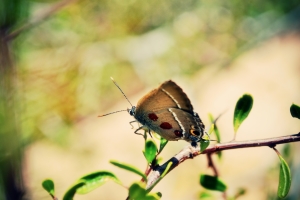
In 2010 I graduated from the Department of Zoology in Trinity College Dublin. I spent the next year travelling and completing any wildlife related internship or voluntary position I could get my hands on. I soon faced a dilemma; should I follow in the footsteps of my friends in academia and find a PhD or should I keep searching for a conservation job? I really didn’t know if academia was for me but I knew it would be a great advantage if I wanted to make any kind of an impact in the conservation world. I didn’t really want to do a taught Masters, I had enough of exams and I felt I needed to get a bigger more meaningful project under my belt. A Research Masters proved to be exactly what I was looking for. I could sample postgraduate life without having to commit for four years but at the same time I knew I would have enough time to do something of consequence. I shopped around and eventually the idea of doing a Masters in Nottingham started to appeal to me (aided in no small way by the fact my girlfriend had decided to do a Masters there!).
I decided to meet up with my potential supervisors in Nottingham to see what sort of projects they had in mind. They had a plethora of ideas and were determined to find a project that suited my interests and abilities. All their conservation work takes place in the Sinai Peninsula in Egypt and the University of Nottingham has a long established research history with the Sinai. Francis Gilbert (one of my potential supervisors) has fallen in love with the Sinai and has spent over 25 years researching there. His obvious passion and enthusiasm for Sinai was one of the major reasons I eventually chose this Masters. We talked through a variety of ideas but it eventually boiled down to one exciting project. It was proposed that I could carry out the first ever study of an extremely rare endemic butterfly found only around the mountains of the Saint Katherine Protectorate – the Sinai Hairstreak Satyrium jebelia. The butterfly was discovered in 1974 and other than a basic description there was next to nothing known about it. YES PLEASE. Ultimately the chance to carry out some old fashioned, pioneering Zoological research was too juicy to pass up! It also appealed to my dormant inner Lepidopterist (I kept butterfly record books with grid references when I was 11 years old) so that made the decision that little bit easier!
I accepted the Masters and started work in Nottingham in January. We had a vague idea of the flight season of the butterfly and to err on the side of caution (and to spend more time in Egypt!) we booked flights for a whopper four month field season in Egypt. I was insistent that I was there before the butterfly emerged right up to the bitter end. I was given a desk and a laptop and lumped in with other Masters and PhD students, which was great. There was no real differentiation between Masters and PhD students and it gave me a real taste for PhD life. My flight out was not until mid-April so I had considerable amount of time to do some preliminary research. This was a little frustrating because we had no idea what to expect and what I would be doing (a difficulty many field researchers and undergraduate dissertation students know too well). I had to be prepared for any eventuality and the thought occurred to me that this species could be extinct! My priority was to fully map its distribution and get the first ever population estimate for the species, absolutely essential information in wildlife conservation. It would also be impossible not to pick up some other useful information on the way. I researched everything from phylogeny to the best kinds of butterfly nets. The genus this butterfly belongs to is typically found in temperate regions of Europe and North America so why is it found in Egypt much further south than its cousins? The Sinai Peninsula and Egypt were once much cooler and had a much more European climate. Sinai Hairstreaks were probably much more widespread in the past but as the region became warmer the species started to die out. Butterflies are reliant on the distribution of their larval foodplant (what their caterpillars feed on) and it is likely that the Sinai Hairstreaks larval foodplant – Sinai Buckthorn Rhamnus dispermus – could not survive the extreme heat. The only way they could survive was to either move north to cooler climates or to move up in altitude where the environment is much cooler. The Saint Katherine Protectorate boasts the highest mountains in Egypt and has the coolest temperatures, making it a biodiversity hotspot and the last remaining home of the Sinai Hairstreak. I continued to work hard but it did become tedious (I did sneak off more than once to birdwatch in Nottingham…..they have Woodpeckers!) and spent a lot of time reading a PhD thesis by Mike James. He carried out the first ever study of another Sinai endemic butterfly – the Sinai Baton Blue. His thesis was the bible as far as I was concerned and a real inspiration. In one field season he carried out a 97 consecutive day Mark-Release Recapture experiment, legendary!
Eventually the time came where I had to fly to Sinai and I didn’t feel so prepared then! Being a pale Irish person with a ginger beard I was a little nervous about the hot Egyptian sun; a gallon of Factor 50 was packed. I flew to Sharm El-Sheikh airport at the southern tip of Sinai (a popular resort town for sun seekers) and was told a Bedouin from St Katherine was going to pick me up. The word Bedouin is generally used to describe Arabic tribes of a nomadic lifestyle that live throughout North Africa and the Middle East. However, the Bedouin in St Katherine live a more settled lifestyle as they take advantage of the tourism to Mount Sinai (where Moses is said to have read the Ten Commandments) and the Monastery of Saint Katherine. They belong to the Jebelia tribe and the Sinai Hairstreak is named after them – Satyrium jebelia. Eventually my driver showed up and, after a detour or two, (he turned a three hour drive into a six hour drive) we arrived at Fox Camp, lying at the foot of Mount Sinai. I was greeted by some familiar faces because there was a team of different Nottingham researchers there looking at everything from hyenas and wolves to the birds and bees (literally). I was invited to join my fellow researchers and some locals by the fire in the Bedouin tent. This would become a daily routine, talking to my Nottingham friends, the locals and strange tourists over Bedouin tea (ingredients: a small amount of water and black tea with a kilo of sugar).
The first week or so was the acclimatisation period, getting used to the sun and helping some of the other researchers (catching Black-crowned Wheatears with Luke and setting up camera traps for carnivores with Lisa). The first thing I wanted to do was to map all the hostplants, Sinai Buckthorn (a rare and endemic species in its own right) before the butterfly was due to emerge. If I could find the hostplants I could find the butterflies. This proved a little more difficult than I originally thought. I had to rely on local knowledge to find these plants and the Sinai Buckthorn has no real value to the Bedouin so many people don’t know what it is. They often confused it with the similar looking (and more common) Sinai Hawthorn. This lead to being sent on more than one wild goose chase. It is illegal to walk the mountains in the Sinai without taking a local guide with you. This also proved a bit of a nightmare at the start as the first guide I was given was 14 years old and didn’t speak English. I didn’t care too much that he didn’t speak English (it’s his country) but he just didn’t understand what he was supposed to be doing, through no real fault of his own. He would take me to the top of mountain and treated me like a tourist and not a scientist…..so I paid him and sacked him! Eventually I settled on my guide – Suileman Abusada- who spoke English. Unfortunately he didn’t really know anything about the plant but pretended he did. He was so eager to secure my services that he gave me rugs and gifts after our first walk. While he didn’t know much about the hostplant he did know the area very well, was a good cook and was willing to spend days on end in the mountains with me while I looked for the plants. I used a GPS to mark the location of the Buckthorn and started the mapping process. Luckily there was one Bedouin who knew exactly what I was looking for – Nasr Mansour. Nasr exuded coolness (his name means eagle and he has a motorbike) and knew everything there is to know about the flora and fauna of St Katherine. He was already a guide for someone else but I did manage to get him to bring me to some locations and educate Suleiman about what I was looking for.
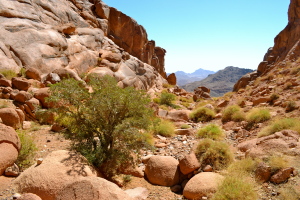
The next few weeks followed the same pattern, long day trips to Wadis (valleys) around the protectorate looking for this shrub and enjoying the spectacular scenery of the region. The Sinai Buckthorn has a nasty habit of being found in remote areas and along steep rocky slopes. On the 10th of May the project really took off, I was climbing up the side of a particularly tedious hill to check out what I expected were two Sinai Buckthorn. The Buckthorn was usually found in relatively high numbers so one or two trees were hardly anything to write home about. I was wrong; I saw the butterfly for the first time (several weeks before they were due to emerge). It was such a relief to the see the species I had been studying for the past four months for the first time. First off I photographed the butterfly (probably the 3rd known photograph for this species!) and I then proceeded to watch them, trying to get familiar with their behaviour. I knew I had an awkward species on my hands as they were quick and would often disappear out of sight chasing after other species of butterfly or just vanishing altogether. Many arid species (such as the Sinai Baton Blue) rarely move more than a few metres but it was immediately clear that the Sinai Hairstreak was a strong flier. I started to practice catching them which was made all the more awkward because the Sinai Buckthorn is covered in thorns, fixing my net was a weekly occurrence. By that time I was fairly satisfied that I had mapped all the hostplants in the region and I knew that it was time to start to try and estimate the population. I found six large sites containing Sinai Buckthorn and a couple of sites with one or two hostplants. I was confident the butterfly would be present in the larger sites despite that it had only been known to occur in two locations. My assumptions were correct and each of the six sites were teaming with butterflies! Hunting season was open!
I wanted to have a reasonably good population estimate so I decided to visit each site for five consecutive days to carry out a Mark-Recapture-Release experiment. I would spend eight hours each day (8:00 – 16:00) for five days catching butterflies. This sounds easy but this was (obviously) the hottest part of the day and the trees could be scattered along various different steep slopes. More often than not I was also competing against a dodgy stomach, watch out for the salad! Even the local Bedouin don’t like being out in the heat of the day, Suleiman rarely helped and spent most days sleeping in the shade! He was good craic and cooked so no problems there. The sites were quite remote so I would camp for the five days with Suleiman. We would bring a camel, Abdul, with us to carry our food and water. Each butterfly captured was given an individual mark with a felt-tip pen through the net and released as quickly as possible. The location, behaviour and time were recorded for each capture or subsequent recapture. By looking at the proportion of marked and unmarked individuals we can estimate the population size using Eberhardt’s geometric model. Maps were created using Google Earth showing the movements of captured Sinai Hairstreaks, the distribution of Sinai Buckthorn and the Sinai Hairstreak. I used this method on all the sites except for one (the Wadi Ahmar region) because of the apparent high population of Sinai Hairstreaks there. For this site I visited once marking as many butterflies as I could and then returned five days later to count the proportion of marked and unmarked individuals. The population size was estimated using the Lincoln index. Carrying out population estimates at each site took a good chunk of time and I was afraid the flight season would end while I was still doing it. As I result I worked non-stop during this time which was pretty intense but very exciting. I took notes on everything I could from predators to foodplants while I was catching the butterflies. I also decided to assess the habitat and larval foodplant requirements by recording 11 different features from the height and width to the slope and aspect of every single Sinai Buckthorn, 553 in total. This was much less enjoyable and much more labour intensive than catching butterflies!

It wasn’t long until August came around and the butterflies were completely gone by the time I left. The heat in August was blistering and I was ready to leave after four long months. I returned to Nottingham with a mountain of data and a decent tan. I effectively became a hermit (tan receded quickly) for the next couple of months writing as much as I could without the distraction of exams or lab work. I estimated the total world population of Sinai Hairstreaks to be 1,010 individuals (less than Snow Leopard and Giant Panda). This is very low but unlike many endangered species the Sinai Hairstreak has a naturally small population size. As I mentioned before the Sinai Hairstreak is a relict species that has become isolated on a mountain-top island to avoid the higher temperatures of lowland Egypt. The good news is the Sinai Hairstreak is not under direct threat from people; the foodplant is not used by the locals (they harvest the foodplant of the Sinai Baton Blue) or grazed heavily and the habitat is not being destroyed by human development. I was also keen to establish what population structure the Sinai Hairstreak has. Basing a conservation strategy on the wrong population structure has proved costly in the past. We can do this by looking at the proximity of sites and the dispersal ability of the butterfly. This definitely needs more research but we now know the Sinai Hairstreak is a good flier (I had one beast fly a kilometre in a day). The Sinai Hairstreak may exist as a metapopulation or a panmictic population. It certainly appears to be in a better position than the Sinai Baton Blue. If the Sinai Baton Blue becomes locally extinct in one patch of suitable habitat it is likely that patch will never be recolonized again due to its extremely poor dispersal ability. I also found an individual Sinai Hairstreak that was 25 days old (very good for a butterfly) which is another indication of how robust it can be. The bad news; the only serious threat that the Sinai Hairstreak is under is global warming, if current climate-change predictions are correct the habitat may become unsuitable and there may be no way for the Sinai Hairstreak to survive. They have already reached the top of Egypt’s highest mountain and have literally nowhere left to go to escape the heat.
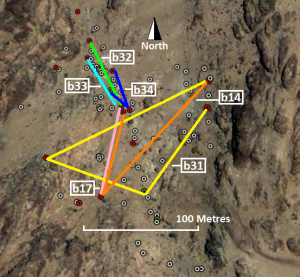
My work in Sinai was recently published in the journal of Insect Conservation. After I finished my Masters I was invited to attend an IUCN Red List Assessment Workshop on Mediterranean Butterflies in Malaga as an expert in Egyptian butterflies (a very generous statement!) and I was involved directly in the creation of a new regional Red List for Mediterranean butterflies. The information I collected was used to have the Sinai Hairstreak red listed for the first time as Vulnerable. Getting a species on the Red List is a necessary first step in highlighting the conservation concern of a species and I was delighted to get the ball rolling for the Sinai Hairstreak. To sum things up I was thrilled to be able to shed some light on an unstudied species and even more delighted that my research could actually prove useful! It’s hard to believe that it all happened in a single year.
More photos of the wildlife and scenery of the Sinai can be found here.
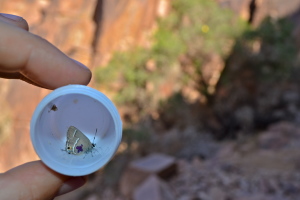
Author Andrew Power
Photo credit Andrew Power


